For a certain kind of young consumer, the prevailing TikTok connotations all imply the same cynicisms: If you’re wearing a Nirvana shirt (and especially if you’re a girl), you probably can’t name five Nirvana songs. If you’re wearing a Thrasher hoodie, you’ve likely never set foot on a board. And if you’re wearing a Bass Pro hat, you’ve never seen a live trout in all your life. It’s an extension of what feels like a tale as old as time: cross-generational ire playing out on the battlefields of gate-kept band T-shirts.
The antidote to these hyper-online implications, though, is the hard reality that wearing culturally or temporally anachronistic merch simply because it looks cool is a time-honored tradition. It is also a sign that the internet is still capable of doing one of the best things it’s best at: introducing people to references outside of their usual scope, whether it’s the decades-old music of a band like Nirvana, or the high-physical-barrier-to-entry world of skateboarding, or the somewhat site-specific pastime of hunting and fishing.
Casey Lewis views this as the continued softening on the value proposition of authenticity about one’s identity-making interests, which remains a defining value and distress point among Generation X and millennials.
Looking back to her formative years in the ’90s and early 2000s, Lewis remembers the “shame associated with being a poser, where I think if you wore a band tee that you weren’t actually a fan of, then people would call you a poser. I would see that play out in teen magazines, or you’d see it play out in movies.” Few insults stung worse. “But now [many] of the ‘trending aesthetics’ we see are kind of the definition of poser: cottagecore, fairycore. People are trying on these identities that they aren’t, but there’s no shame associated with it now.”
“Something about these days with micro-trends and TikTok, and you can try on different identities much easier,” Lewis says. “Now it’s like you don’t even have to wear that look to your high school to experiment with your style. You can literally just post a video of yourself on TikTok to see how it fits, how that look suits you.” Life is but a department store beauty floor of possibility—why wouldn’t you care for a spritz of eau de counterculture?
According to New York Times critic and longtime merch connoisseur Jon Caramanica, cross-generationally popular merch is merely a sign of the source material’s potency. “Whether it was Nirvana or Thrasher or whatever, they won. They formed a cultural identity that was so powerful that it outlasted the actual thing,” he says.
“I’m going to assume if you’re wearing a Nirvana shirt in 2024 and you don’t know the band, maybe you have a sense that they were edgy. Maybe you have a sense that they rebelled. Maybe you’re trying to tell some part of that story,” Caramanica explains. “It’s not that different, frankly, from kids of my generation wearing Ramones T-shirts. None of y’all saw the Ramones.” Not dissimilarly, in 2015, GQ asked Fear of God founder and heavy-duty vintage band-shirt collector Jerry Lorenzo if he thought someone ought to be a card-carrying fan in order to rock a Nirvana tee; he said no, if only because “having played a small role in Kanye’s Yeezus tour merch, I’m just excited to see people wear it.”
The potential for discovery outweighs the preciousness of hard-wrought fandom. “Out of a hundred kids who are under 20 wearing a Nirvana shirt, maybe five of them go research the band and they find something fascinating and get really into it,” says Caramanica. “That, to me, is far more interesting than being on the churlish end of things and being like, ‘You don’t know In Utero.’”
Read the full article here








